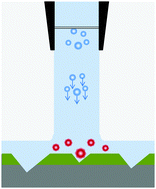Electrochemical ‘bubble swarm’ enhancement of ultrasonic surface cleaning†
Abstract
An investigation of surface cleaning using a swarm of gas bubbles within an acoustically activated stream is presented. Electrolysis of water at Pt microwires (100 μm diameter) to produce both hydrogen and oxygen bubbles is shown to enhance the extent of ultrasonic surface cleaning in a free flowing water stream containing an electrolyte (0.1 M Na2SO4) and low surfactant concentration (2 mM SDS). The surfactant was employed to allow control of the average size of the bubble population within the swarm. The electrochemical bubble swarm (EBS) is shown to perturb acoustic transmission through the stream. To optimise the cleaning process both the ultrasonic field and the electrochemical current are pulsed and synchronized but with different duty cycles. Cleaning action is demonstrated on structured surfaces (porcine skin and finger mimics) loaded with fluorescent particles. This action is shown to be significantly enhanced compared to that found with an inherent bubble population produced by the flow and acoustic regime alone under the same conditions.


 Please wait while we load your content...
Please wait while we load your content...